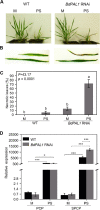Brachypodium Phenylalanine Ammonia Lyase (PAL) Promotes Antiviral Defenses against Panicum mosaic virus and Its Satellites
- PMID: 33593968
- PMCID: PMC8545123
- DOI: 10.1128/mBio.03518-20
Brachypodium Phenylalanine Ammonia Lyase (PAL) Promotes Antiviral Defenses against Panicum mosaic virus and Its Satellites
Abstract
Brachypodium distachyon has recently emerged as a premier model plant for monocot biology, akin to Arabidopsis thaliana We previously reported genome-wide transcriptomic and alternative splicing changes occurring in Brachypodium during compatible infections with Panicum mosaic virus (PMV) and its satellite virus (SPMV). Here, we dissected the role of Brachypodium phenylalanine ammonia lyase 1 (PAL1), a key enzyme for phenylpropanoid and salicylic acid (SA) biosynthesis and the induction of plant defenses. Targeted metabolomics profiling of PMV-infected and PMV- plus SPMV-infected (PMV/SPMV) Brachypodium plants revealed enhanced levels of multiple defense-related hormones and metabolites such as cinnamic acid, SA, and fatty acids and lignin precursors during disease progression. The virus-induced accumulation of SA and lignin was significantly suppressed upon knockdown of B. distachyonPAL1 (BdPAL1) using RNA interference (RNAi). The compromised SA accumulation in PMV/SPMV-infected BdPAL1 RNAi plants correlated with weaker induction of multiple SA-related defense gene markers (pathogenesis related 1 [PR-1], PR-3, PR-5, and WRKY75) and enhanced susceptibility to PMV/SPMV compared to that of wild-type (WT) plants. Furthermore, exogenous application of SA alleviated the PMV/SPMV necrotic disease phenotypes and delayed plant death caused by single and mixed infections. Together, our results support an antiviral role for BdPAL1 during compatible host-virus interaction, perhaps as a last resort attempt to rescue the infected plant.IMPORTANCE Although the role of plant defense mechanisms against viruses are relatively well studied in dicots and in incompatible plant-microbe interactions, studies of their roles in compatible interactions and in grasses are lagging behind. In this study, we leveraged the emerging grass model Brachypodium and genetic resources to dissect Panicum mosaic virus (PMV)- and its satellite virus (SPMV)-compatible grass-virus interactions. We found a significant role for PAL1 in the production of salicylic acid (SA) in response to PMV/SPMV infections and that SA is an essential component of the defense response preventing the plant from succumbing to viral infection. Our results suggest a convergent role for the SA defense pathway in both compatible and incompatible plant-virus interactions and underscore the utility of Brachypodium for grass-virus biology.
Keywords: bioenergy; defense hormones; grasses; metabolic pathways; plant-virus interactions.
Figures






Similar articles
-
Characterization of a viral synergism in the monocot Brachypodium distachyon reveals distinctly altered host molecular processes associated with disease.Plant Physiol. 2012 Nov;160(3):1432-52. doi: 10.1104/pp.112.204362. Epub 2012 Sep 6. Plant Physiol. 2012. PMID: 22961132 Free PMC article.
-
Comparative analysis of antiviral responses in Brachypodium distachyon and Setaria viridis reveals conserved and unique outcomes among C3 and C4 plant defenses.Mol Plant Microbe Interact. 2014 Nov;27(11):1277-90. doi: 10.1094/MPMI-05-14-0152-R. Mol Plant Microbe Interact. 2014. PMID: 25296115
-
Panicum Mosaic Virus and Its Satellites Acquire RNA Modifications Associated with Host-Mediated Antiviral Degradation.mBio. 2019 Aug 27;10(4):e01900-19. doi: 10.1128/mBio.01900-19. mBio. 2019. PMID: 31455653 Free PMC article.
-
Biosynthesis of salicylic acid in plants.Plant Signal Behav. 2009 Jun;4(6):493-6. doi: 10.4161/psb.4.6.8392. Epub 2009 Jun 12. Plant Signal Behav. 2009. PMID: 19816125 Free PMC article. Review.
-
Biosynthesis and Roles of Salicylic Acid in Balancing Stress Response and Growth in Plants.Int J Mol Sci. 2021 Oct 28;22(21):11672. doi: 10.3390/ijms222111672. Int J Mol Sci. 2021. PMID: 34769103 Free PMC article. Review.
Cited by
-
Exploring the physiological, biochemical, and enzymatic responses of Vigna mungo varieties to Mungbean Yellow Mosaic India Virus (MYMIV) infection.Sci Rep. 2025 Jan 7;15(1):1049. doi: 10.1038/s41598-024-84990-0. Sci Rep. 2025. PMID: 39775173 Free PMC article.
-
Comparative analysis of Fusarium crown rot resistance in synthetic hexaploid wheats and their parental genotypes.BMC Genomics. 2023 Apr 5;24(1):178. doi: 10.1186/s12864-023-09268-7. BMC Genomics. 2023. PMID: 37020178 Free PMC article.
-
Styrene Production in Genetically Engineered Escherichia coli in a Two-Phase Culture.BioTech (Basel). 2024 Jan 14;13(1):2. doi: 10.3390/biotech13010002. BioTech (Basel). 2024. PMID: 38247732 Free PMC article.
-
Integrated transcriptome and microRNA sequencing analyses reveal gene responses in poplar leaves infected by the novel pathogen bean common mosaic virus (BCMV).Front Plant Sci. 2023 Jun 15;14:1163232. doi: 10.3389/fpls.2023.1163232. eCollection 2023. Front Plant Sci. 2023. PMID: 37396641 Free PMC article.
-
Transcriptomic insights into the molecular mechanism for response of wild emmer wheat to stripe rust fungus.Front Plant Sci. 2024 Jan 3;14:1320976. doi: 10.3389/fpls.2023.1320976. eCollection 2023. Front Plant Sci. 2024. PMID: 38235210 Free PMC article.
References
-
- Yang H, Gou X, He K, Xi D, Du J, Lin H, Li J. 2010. BAK1 and BKK1 in Arabidopsis thaliana confer reduced susceptibility to Turnip crinkle virus. Eur J Plant Pathol 127:149–156. doi:10.1007/s10658-010-9581-5. - DOI
Publication types
MeSH terms
Substances
Supplementary concepts
LinkOut - more resources
Full Text Sources
Other Literature Sources
Research Materials

